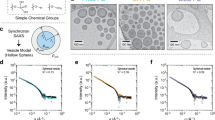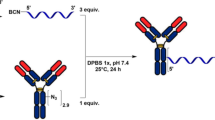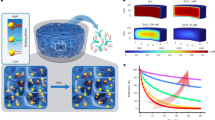Abstract
To promote drug delivery to exact sites and cell types, the surface of nanocarriers is functionalized with targeting antibodies or ligands, typically coupled by covalent chemistry. Once the nanocarrier is exposed to biological fluid such as plasma, however, its surface is inevitably covered with various biomolecules forming the protein corona, which masks the targeting ability of the nanoparticle. Here, we show that we can use a pre-adsorption process to attach targeting antibodies to the surface of the nanocarrier. Pre-adsorbed antibodies remain functional and are not completely exchanged or covered by the biomolecular corona, whereas coupled antibodies are more affected by this shielding. We conclude that pre-adsorption is potentially a versatile, efficient and rapid method of attaching targeting moieties to the surface of nanocarriers.
This is a preview of subscription content, access via your institution
Access options
Access Nature and 54 other Nature Portfolio journals
Get Nature+, our best-value online-access subscription
$29.99 / 30 days
cancel any time
Subscribe to this journal
Receive 12 print issues and online access
$259.00 per year
only $21.58 per issue
Buy this article
- Purchase on Springer Link
- Instant access to full article PDF
Prices may be subject to local taxes which are calculated during checkout




Similar content being viewed by others
References
Cheng, C. J., Tietjen, G. T., Saucier-Sawyer, J. K. & Saltzman, W. M. A holistic approach to targeting disease with polymeric nanoparticles. Nat. Rev. Drug. Discov. 14, 239–247 (2015).
Blanco, E., Shen, H. & Ferrari, M. Principles of nanoparticle design for overcoming biological barriers to drug delivery. Nat. Biotechnol. 33, 941–951 (2015).
Zyuzin, M. V. et al. Role of the protein corona derived from human plasma in cellular interactions between nanoporous human serum albumin particles and endothelial cells. Bioconj. Chem. 28, 2062–2068 (2017).
Carter, T., Mulholland, P. & Chester, K. Antibody-targeted nanoparticles for cancer treatment. Immunotherapy 8, 941–958 (2016).
Puertas, S. et al. Taking advantage of unspecific interactions to produce highly active magnetic nanoparticle-antibody conjugates. ACS Nano. 5, 4521–4528 (2011).
Dai, Q. et al. Particle targeting in complex biological media. Adv. Healthc. Mater. 7, 1700575 (2018).
Kocbek, P., Obermajer, N., Cegnar, M., Kos, J. & Kristl, J. Targeting cancer cells using PLGA nanoparticles surface modified with monoclonal antibody. J. Control. Release 120, 18–26 (2007).
Monopoli, M. P., Aberg, C., Salvati, A. & Dawson, K. A. Biomolecular coronas provide the biological identity of nanosized materials. Nat. Nanotech. 7, 779–786 (2012).
Salvati, A. et al. Transferrin-functionalized nanoparticles lose their targeting capabilities when a biomolecule corona adsorbs on the surface. Nat. Nanotech. 8, 137–143 (2013).
Schöttler, S. et al. Protein adsorption is required for stealth effect of poly(ethylene glycol)- and poly(phosphoester)-coated nanocarriers. Nat. Nanotech. 11, 372–377 (2016).
Zangar, R. C., Daly, D. S. & White, A. M. ELISA microarray technology as a high-throughput system for cancer biomarker validation. Expert Rev. Proteom. 3, 37–44 (2006).
Dai, Q. et al. Targeting ability of affibody-functionalized particles is enhanced by albumin but inhibited by serum coronas. ACS Macro Lett. 4, 1259–1263 (2015).
Dai, Q. et al. Monoclonal antibody-functionalized multilayered particles: targeting cancer cells in the presence of protein coronas. ACS Nano. 9, 2876–2885 (2016).
Kang, B. et al. Carbohydrate-based nanocarriers exhibiting specific cell targeting with minimum influence from the protein corona. Angew. Chem. Int. Ed. 54, 7436–7440 (2015).
Ju, Y. et al. Improving targeting of metal-phenolic capsules by the presence of protein coronas. ACS Appl. Mater. Interfaces 8, 22914–22922 (2016).
Mirshafiee, V., Mahmoudi, M., Lou, K., Cheng, J. & Kraft, M. L. Protein corona significantly reduces active targeting yield. Chem. Commun. 49, 2557–2559 (2013).
Zarschler, K. et al. Diagnostic nanoparticle targeting of the EGF-receptor in complex biological conditions using single-domain antibodies. Nanoscale 6, 6046–6056 (2014).
Ritz, S. et al. Protein corona of nanoparticles: distinct proteins regulate the cellular uptake. Biomacromolecules 16, 1311–1321 (2015).
Caracciolo, G. et al. Stealth effect of biomolecular corona on nanoparticle uptake by immune cells. Langmuir 31, 10764–10773 (2015).
Behzadi, S. et al. Cellular uptake of nanoparticles: journey inside the cell. Chem. Soc. Rev. 46, 4218–4244 (2017).
Ring, S., Maas, M., Nettelbeck, D. M., Enk, A. H. & Mahnke, K. Targeting of autoantigens to DEC205+ dendritic cells in vivo suppresses experimental allergic encephalomyelitis in mice. J. Immunol. 191, 2938–2947 (2013).
Hofmann, D. et al. Mass spectrometry and imaging analysis of nanoparticle-containing vesicles provide a mechanistic insight into cellular trafficking. ACS Nano. 8, 10077–10088 (2014).
Mantegazza, A. R. et al. CD63 tetraspanin slows down cell migration and translocates to the endosomal-lysosomal-MIICs route after extracellular stimuli in human immature dendritic cells. Blood 104, 1183–1190 (2004).
Ramirez, L. P. & Landfester, K. Magnetic polystyrene nanoparticles with a high magnetite content obtained by miniemulsion processes. Macromol. Chem. Phys. 204, 22–31 (2003).
Lewis, V. et al. Glycoproteins of the lysosomal membrane. J. Cell Biol. 100, 1839–1847 (1985).
Mizuhara, T. et al. Acylsulfonamide-functionalized zwitterionic gold nanoparticles for enhanced cellular uptake at tumor pH. Angew. Chem. Int. Ed. 54, 6567–6570 (2015).
Kelly, P. M. et al. Mapping protein binding sites on the biomolecular corona of nanoparticles. Nat. Nanotech. 10, 472–479 (2015).
Lo Giudice, M. C., Herda, L. M., Polo, E. & Dawson, K. A. In situ characterization of nanoparticle biomolecular interactions in complex biological media by flow cytometry. Nat. Commun. 7, 13475 (2016).
Herda, L. M., Hristov, D. R., Lo Giudice, M. C., Polo, E. & Dawson, K. A. Mapping of molecular structure of the nanoscale surface in bionanoparticles. J. Am. Chem. Soc. 139, 111–114 (2017).
Estupiñán, D. et al. Multifunctional clickable and protein-repellent magnetic silica nanoparticles. Nanoscale 8, 3019–3030 (2016).
Harris, L. J., Skaletsky, E. & McPherson, A. Crystallographic structure of an intact IgG1 monoclonal antibody. J. Mol. Biol. 275, 861–872 (1998).
Wang, K., Zhou, C., Hong, Y. & Zhang, X. A review of protein adsorption on bioceramics. Interface Focus. 2, 259–277 (2012).
Ito, T. & Tsumoto, K. Effects of subclass change on the structural stability of chimeric, humanized, and human antibodies under thermal stress. Protein Sci. 22, 1542–1551 (2013).
Chaudhuri, R., Cheng, Y., Middaugh, C. R. & Volkin, D. B. High-throughput biophysical analysis of protein therapeutics to examine interrelationships between aggregate formation and conformational stability. AAPS J. 16, 48–64 (2013).
Latypov, R. F., Hogan, S., Lau, H., Gadgil, H. & Liu, D. Elucidation of acid-induced unfolding and aggregation of human immunoglobulin IgG1 and IgG2 Fc. J. Biol. Chem. 287, 1381–1396 (2012).
Boswell, C. A. et al. Effects of charge on antibody tissue distribution and pharmacokinetics. Bioconjug. Chem. 21, 2153–2163 (2010).
Torcello-Gómez, A. et al. Adsorption of antibody onto Pluronic F68-covered nanoparticles: link with surface properties. Soft Matter 7, 8450–8461 (2011).
Qian, W. et al. Immobilization of antibodies on ultraflat polystyrene surfaces. Clin. Chem. 46, 1456–1463 (2000).
Fleischer, C. C. & Payne, C. K. Secondary structure of corona proteins determines the cell surface receptors used by nanoparticles. J. Phys. Chem. B 118, 14017–14026 (2014).
Temel, D. B., Landsman, P. & Brader, M. L. Orthogonal methods for characterizing the unfolding of therapeutic monoclonal antibodies: differential scanning calorimetry, isothermal chemical denaturation, and intrinsic fluorescence with concomitant static light scattering. Methods Enzymol. 567, 359–389 (2016).
Frick, S. U. et al. Interleukin-2 functionalized nanocapsules for T cell-based immunotherapy. ACS Nano. 10, 9216–9226 (2016).
Maffre, P. et al. Effects of surface functionalization on the adsorption of human serum albumin onto nanoparticles–a fluorescence correlation spectroscopy study. Beilstein J. Nanotechnol. 7, 2036–2047 (2014).
Schöttler, S., Klein, K., Landfester, K. & Mailänder, V. Protein source and choice of anticoagulant decisively affect nanoparticle protein corona and cellular uptake. Nanoscale 8, 5526–5536 (2016).
Pozzi, D. et al. Surface chemistry and serum type both determine the nanoparticle-protein corona. J. Proteom. 119, 209–217 (2015).
Deng, Z. J., Liang, M., Monteiro, M., Toth, I. & Minchin, R. F. Nanoparticle-induced unfolding of fibrinogen promotes Mac-1 receptor activation and inflammation. Nat. Nanotech. 6, 39–44 (2011).
Mirshafiee, V., Kim, R., Park, S., Mahmoudi, M. & Kraft, M. L. Impact of protein pre-coating on the protein corona composition and nanoparticle cellular uptake. Biomaterials 75, 295–304 (2016).
Chen, F. et al. Complement proteins bind to nanoparticle protein corona and undergo dynamic exchange in vivo. Nat. Nanotech. 12, 387–393 (2017).
Caracciolo, G., Farokhzad, O. C. & Mahmoudi, M. Biological identity of nanoparticles in vivo: clinical implications of the protein corona. Trends Biotechnol. 35, 257–264 (2017).
Bannwarth, M. B. et al. Colloidal polymers with controlled sequence and branching constructed from magnetic field assembled nanoparticles. ACS Nano 9, 2720–2728 (2015).
Renz, P., Kokkinopoulou, M., Landfester, K. & Lieberwirth, I. Imaging of polymeric nanoparticles: hard challenge for soft objects. Macromol. Chem. Phys. 217, 1879–1885 (2016).
Acknowledgements
We wish to thank the Deutsche Forschungsgemeinschaft (DFG, SFB1066) for supporting this study. Support from the Max Planck Society is also gratefully acknowledged. In addition, we would like to thank C. Siebert and C. Sauer for their technical support.
Author contributions
V.M., K.L. and D.C. supervised the project. V.M., M.T. and J.S. conceived and designed the experiments. D.E. synthesized the nanoparticles. M.K., P.R. and I.L performed the transmission electron microscopy analysis. J.R. contributed to the figure illustration and protein structure analysis. U.K. and A.K. performed the confocal electron microscopy experiments. M.P.D. and K.S. contributed with additional biological assays. All authors discussed the results and commented on the manuscript.
Author information
Authors and Affiliations
Corresponding author
Ethics declarations
Competing interests
The authors declare no competing interests.
Additional information
Publisher’s note: Springer Nature remains neutral with regard to jurisdictional claims in published maps and institutional affiliations.
Supplementary information
Supplementary Information
Supplementary Tables 1–5, Supplementary Figures 1–42, Supplementary Methods, Supplementary References
Supplementary Dataset
Supplementary Table 5
Rights and permissions
About this article
Cite this article
Tonigold, M., Simon, J., Estupiñán, D. et al. Pre-adsorption of antibodies enables targeting of nanocarriers despite a biomolecular corona. Nature Nanotech 13, 862–869 (2018). https://doi.org/10.1038/s41565-018-0171-6
Received:
Accepted:
Published:
Issue Date:
DOI: https://doi.org/10.1038/s41565-018-0171-6
This article is cited by
-
Controlled adsorption of multiple bioactive proteins enables targeted mast cell nanotherapy
Nature Nanotechnology (2024)
-
Nano–Bio Interactions: Exploring the Biological Behavior and the Fate of Lipid-Based Gene Delivery Systems
BioDrugs (2024)
-
The protein corona from nanomedicine to environmental science
Nature Reviews Materials (2023)
-
Cholesterol removal improves performance of a model biomimetic system to co-deliver a photothermal agent and a STING agonist for cancer immunotherapy
Nature Communications (2023)
-
Endosomal sorting results in a selective separation of the protein corona from nanoparticles
Nature Communications (2023)



